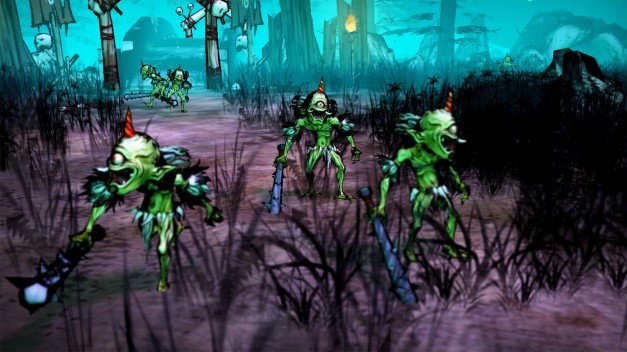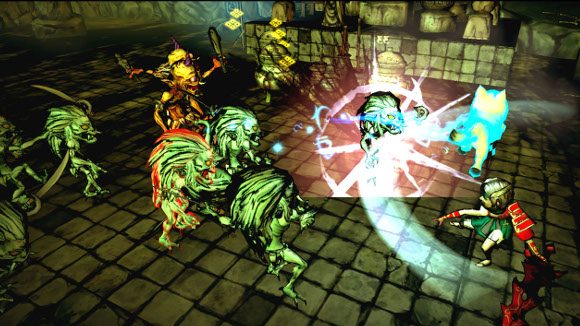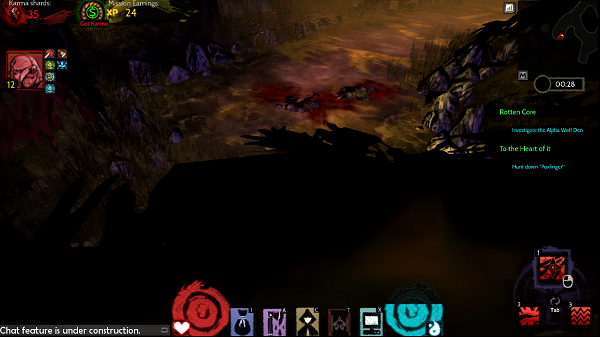
We’ve been keeping a close eye on Akaneiro: Demon Hunters for a while now. It made Kyle’s list of the most anticipated horror games of 2013, we held an interview with American McGee and we of course covered the occasional news item. Now that the game is finally out there and I got to play the final product, I felt the same as when Alice: Madness Returns launched: glad it exists, but disappointed in the quality of the product.
Akaneiro is a mix between the darker side of Japanese folklore and the not-so whimsical fairytale of Little Red Riding Hood. The player gets to pick between three classes of characters and two genders, after which the character they chose will arrive on a small island where demons are running loose. As the title of the game suggests, it is up to you to pick up the weapons and hunt these down. The game is split into various zones which you must unlock, each of which has its own story going on. The first one, for example, is all about demons manipulating the wolves into attacking villages and after you finish the last level in that zone it moves on to another quest-line with another plot.
Before I talk more in-depth about the game itself, I just want to mention that the premise seemed really appealing to me. American McGee has proved himself in the past with the Alice and Grimm franchise, so this project seemed right up his alley to me. However, the Little Red Riding Hood influences are so small that they might as well not be there; there are wolves in the game and your character usually ends up wearing a hood. The Japanese folklore is clearly more emphasized, but not in a way that teaches the player anything. Seeing demons is fair enough, but the game never explains anything about the story behind those demons. Since a large part of the game is spend walking around, it would have been very neat if the player-character randomly dropped some trivia or if the loading screens had some information on them (in similar fashion as Skyrim). As it stands, we might as well have been fighting skeletons in knight costumes.

The gameplay itself is very traditional for an Action-RPG, but there are some nice twists. You use the left mouse-button to move around and if you click on an enemy, then you will attack it. With the right mouse-button you perform a special attack, but you can also map these to the 1, 2 and 3 numerical keys on the keyboard. I would have preferred it if the game used the full 1 to 10 numbers with a bar on the bottom of the screen showing which abilities are mapped to what keys, but it’s a minor hassle. Most missions consist of simple objectives that involve killing specific types of enemies or a boss-character. Killing those and other enemies grants you “Karma”, which serves as the game’s currency, and experience that is used to level up. Additionally, you will constantly run into weapons and armor as you play and these can be equipped to increase damage output and other statistics.
Leveling up is slightly different in Akaneiro than in other titles, but in a somewhat gimmicky way. The gist is that you choose between the three different classes with each level up and it grants you points based on which one you picked. This essentially allows you to mix classes together into hybrids, so you can make a rogue in heavy armor or a dual wielding tank. I didn’t try it, though, since my Prowess character was based on running around really fast and using quick stabs with dual-wielded weapons, so there was no point in slowing myself down or dabbling in abilities that didn’t make me stab anything better. Still, it’s nice to have the option.
One fundamental flaw with the game is the difficulty curve or rather the lack thereof. Each time you unlock a mission it is given a “threat level” and this determines how many enemies, objectives and bosses there will be, as well as how difficult all of those are. “Low Threat” is generally very easy, but beyond that the game would sometimes border on the unfair. At one point I approached the arena for a boss-bottle and was attacked by forty wolves, a dozen or so demons and three copies of the boss. My character was level 2 at that point and there was no way I could possibly win the battle except for constantly using resurrections (that cost a load of karma). This is very common for the game, to just throw unreasonable amounts of enemies on the screen. As a result of that, the most functional tactic is to run in circles, pause occasionally to use an attack that heals you and slowly thin out the horde that way. It looks immensely stupid, there is no challenge or skills required to do it and it works in every fight, even against bosses.

It’s a shame too, since on the lowest threat level (not counting the “Secured” status) you can really see a good ARPG underneath all the trouble. Combat can flow nicely, the controls are very responsive and abilities are generally all useful. There is depth too, since some abilities suit certain situations better than others and each foe has weaknesses that are best exploited with certain builds. Weapons also benefit from simpler statistics, so players are forced to choose between picking that nice hammer with the extra critical chance or that neat sword that does more damage and slightly increases movement speed. If there were more numbers to keep in mind, then these choices would only be made easier since mathematics would offer a clearer answer.
Another major (and in many ways fatal) flaw is that the game requires the player to stay constantly connected to the servers. If the player at any point loses connection to the server (or internet as a whole) he or she is kicked out of the game. In some cases you might luck out and you can reconnect and pick up where you left off, but in most cases you are send back to the HUB-world and have to start the whole mission over again (keep in mind that experience is only rewarded upon mission completion). Even if you manage to reconnect, the game will often glitch out in many different ways. The worst scenarios I have personally encountering is seeing my connection take a dive right after a mission, which caused the experience bar to fill up without advancing my level (this happened three times, by the way). I am already opposed to always online-DRM, but here it doesn’t even make any sense. Akaneiro has no online features, no multi-player and no market, so why do we have to stay connected? Even if any of those features appear in the future, it instantly excludes people with weak connections.
With a story that doesn’t really stand out and gameplay that doesn’t know its strengths, the presentation is forced to carry quite a load; something that it almost pulls off.
The aesthetic Spicy Horse used is distinctively Japanese, but in a way that shows that the artist researched and understand what they are depicting. I remember Chapter 4 from Alice: Madness Returns always struck me as deliberately simplified and stereo-typical, with its origami grasshoppers and 2D-platforming sections. Here, you get to see a whole different side of the culture, complete with brilliant use of colors and a dedication to the theme; there are no distractions, no side-quests, no scenes with alternate art-styles, only pure devotion and it really pays off. The soundtrack is also very fitting, though you will find that a lot of the tunes start sounding alike after a while.

Level-design is however not Akaneiro’s strongest case, since most of the time you’ll be running around interchangeable forests and dungeons. There are some minor variations per stage, mostly involving certain environmental assets, but that’s pretty much everything. Compare that to a title like Torchlight and you immediately notice that there is a severe lack of variety. This is even further worsened by the fact that you need to pay a lot of Karma Shards in order to unlock the zones, so you are going to be grinding the same stages over and over again to accomplish that. It’s either that or buying Karma from Spicy Horse, which I suppose is their way of still getting a little money out of this otherwise free game. I have said this before in conversations about Dead Space 3, but designing your game to nearly force players into purchasing is a blemish that will stick with your art long after it has run its financial course.
As beautiful as the levels tend to look, they do become rather troublesome when they get right up in your face. Akaneiro uses a fixed camera perspective, but that doesn’t mean scenery won’t occasionally block it. In very rare cases an object will become transparent when it blocks your view, but most of the time you get to appreciate the nice texturing on a rock or tree.
Before we move on to a verdict, I would like to mention the reason for why I stopped playing it and which is by far the most disappointing aspect of this game: the boss-fights. There are plenty of bosses and mini-bosses in Akaneiro, but none of them have any real tactic to them. The only way to beat these foes is to outlast them through a combination of health-potions and lucky critical hits. You can also do the aforementioned trick with the running in circles, but sometimes the boss performs an attack that will hit you regardless of where you’re standing, so it can be trick sometimes. When I paid 12000 karma shards to finally unlock the temple level (the only change of scenery in four days of playing) and was put against a mini-boss I had to revive four times on… I just lost it.
So there we go, weeks of anticipation and funding for a game that is nice to look at and possibly well-intended, but that also reeks of a lack of understanding. Having to cough up ridiculous sums of karma isn’t fun, threat levels kill the difficulty curve, having to stay online at all times only serves to make the game a pain in the ass to play and you don’t really learn anything from playing it. The last problem I just mentioned confuses me even more, since American McGee clearly explained that he does a lot of research, so why not share it with us through the game? Overall Akaneiro: Demon Hunters is an alright game by the standards of 2006, but with some points detracted for the constant disconnections and micro-transactions that could have been removed entirely and been more subtle respectively.
 (2.5 / 10)
(2.5 / 10)
Bad
 (2.5 / 10)
(2.5 / 10)




